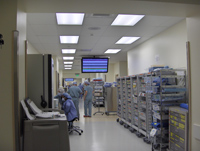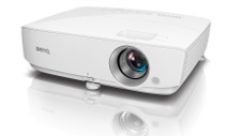

Digital Signage Elevates OR Efficiency
Feb 23, 2010 12:38 PM
St. Joseph Hospital, in Orange County, Calif., is a 3,800-employee healthcare provider. It has become the largest and one of the highest volume hospitals in the region. The hospital is part of the St. Joseph Health System, the 10th largest not-for-profit healthcare provider in the United States.
Related Links

Retrofit Meets Digital Signage at Wisconsin Veterans Museum
At the Wisconsin Veterans Museum, the AV technology that had been cutting-edge in the late ’90s was obsolete….

Novus International Headquarters, St. Charles, Mo.
Novus International creates innovative animal health and nutrition solutions for livestock and companion animals worldwide, with clients in more than 80 countries. In 2008, the company built a new, 4,200-square-meter, Leadership in Energy and Environmental Design (LEED) Platinum-certified international headquarters…

The Case for Digital Signage Content: Viewer Experience Strategies
There are three basic types of digital out of home (DOOH) networks that determine both the placement and approach to creating messages….
Challenge
In any large hospital, a great deal of coordination is required to move patients through the operating facility efficiently and seamlessly, from the pre-operative through to the recovery areas. Which treatment rooms are available? Which patients are ready for surgery next? Has a procedure in the operating room been completed ahead of schedule? Tracking each patient and coordinating resources requires staff to have immediate access to patient case data, at any time. While nurses in the surgical facility had access to the data on their desktop workstations, relevant information was not quickly and easily visible for other staff in the area. St. Joseph Hospital’s goal was to provide doctors, nurses, and orderlies with better visual access to the operative status of each patient in its operating facility—without having to find a terminal and log in.

Implementation
The hospital decided to address the challenge by installing large LCD panels on walls at eye level in the restricted personnel areas of the OR facility. The screens would provide a clear, continuously updated status list of each patient in the operating and treatment areas. These digital signs would tell staff which rooms are available, which patients are ready for transport, and what actions need to be taken for smooth operation of the facility. Patient safety and quality of care would also elevated with this solution.
Working with solution provider Spinitar, the hospital evaluated LCD screens and the requisite software platforms that could handle the job. Software became the number one priority, because data needed to be linked from databases within the hospital’s legacy systems and then automatically sent to specific displays depending on location and the information requirements in that part of the facility. Spinitar selected Omnivex software for its ability to interface with St. Joseph’s Patient Management System (PICIS), alleviating the need for any additional data entry, and for its ability to automatically manage multiple displays from a single control point. Omnivex also allowed the layout and appearance of the information to remain the same as it looked on the PICIS desk terminals, reducing the learning curve for users. As a visual cue, color coding each row of content on the displays provides status updates (e.g. patient ready in pre-operative holding area) to help staff better focus on their individual responsibilities and to signal availability of treatment rooms.
Officials decided that 14 60in. LCD panels would provide good visual access to the information. The design called for eleven LCD panels in the surgery facility (OR), one panel in pre-operative (MPOH), and two panels in the post-operative (PACU) care unit.

Results
As before, the existing patient PICIS database is updated by nurses as patient and operative statuses change. Omnivex software interfaces with the PICIS system and continuously monitors for any changes in the data, formats the data in real-time, and pushes the updates to the appropriate LCD panels.
“Omnivex software delivers intelligent data at the points where the most critical decisions are made,” says Terrence Wooten, business and materials resource director for Surgical Services and Endoscopy at St. Joseph Hospital. “Our staff can now view the current status of each case in real-time, with no additional data entry required.”
Each patient case is listed by row, grouped by OR and circulating staff for that OR. There are 18 columns on the display to indicate patient number, procedure description, site, surgeon, anesthesiologist, procedure start time, anticipated end time, in-room timer, patient bed number, and more. It is a dynamically shrinking list based on OR room occupancy, so if the OR is not occupied, it doesn’t show up on the screen for a simpler and cleaner look.
OR staff have the ability to identify the status of operating rooms, thus improving the efficiencies of the OR facility. For example, orderlies and custodians watch for rows to turn purple, indicating the procedure is wrapping up, so they can prepare to service the room for the next case.
A Windows XP server runs Omnivex software to centrally control operation of the network of screens. Three “player” PCs drive the video signals to the 14 screens. Because the PCs are located centrally in the server room, the DVI video signals from the PCs are converted to fiber optic using Extron converters, to allow a 200ft.-to-400ft. cable run, where another Extron unit converts the signal back to DVI for the LCD panels.
The results from the installation of the system have been phenomenal. “St. Joseph’s has seen improved efficiency, improved teamwork, and a better informed staff without any additional data entry or administrative burden,” Wooten says.
Design Team: Terrence A. Wooten (Business and Materials Resource Director for
Surgical Services and Endoscopy, St. Joseph Hospital); Kenneth Gisstennar, President, Spinitar; John Abbott, Spinitar; Joe Rafalik, Spinitar; Gaurav Shewaramani, application engineer, Omnivex; Susie Sorensen, System Administrator at St. Joseph’s.
Budget: Met budgetary goals but not publicly available information
Length of Project: Less than 4 weeks
Date of Completion: October 2007










